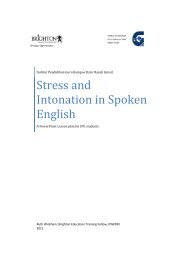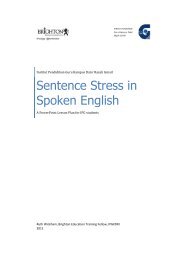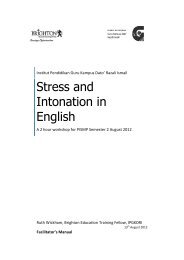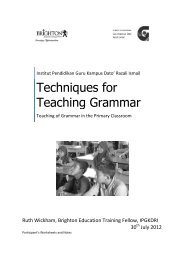Teaching English Grammar in Malaysian Primary Schools
Teaching English Grammar in Malaysian Primary Schools
Teaching English Grammar in Malaysian Primary Schools
You also want an ePaper? Increase the reach of your titles
YUMPU automatically turns print PDFs into web optimized ePapers that Google loves.
<strong>English</strong> <strong>Grammar</strong> <strong>in</strong> <strong>Malaysian</strong> <strong>Primary</strong> <strong>Schools</strong>2. B<strong>in</strong>goThis long time favourite keeps students of all ages engrossed and concentrat<strong>in</strong>g on the page<strong>in</strong> front of them.a) Markers:Use objects as markers, with the students plac<strong>in</strong>g them over words as they hear them and thenremov<strong>in</strong>g them to start a fresh game with the same card. (If the students mark the cards, theywill only be usable for one game.)Many th<strong>in</strong>gs can be used as markers, <strong>in</strong>clud<strong>in</strong>g counters, pieces of cardboard, or small stones.Depend<strong>in</strong>g on the age and maturity of the students, sunflower seeds are a popular option(allow<strong>in</strong>g the students to nibble on the seeds as they play, but be<strong>in</strong>g careful with the husks.)b) Game format:The most common size is 5 x 5, a total of 25 words, phrases, numbers or pictures. Howeverthe game can be varied to 4 x 4, 3 x 3, or any size that works for you. Students call “B<strong>in</strong>go!”when they have marked a full row <strong>in</strong> any direction (horizontal, vertical or diagonal).The game can be designed so that every card conta<strong>in</strong>s the same items, randomly rearranged.However, with a larger number of examples, each card only has a selection of the possibleanswers. In this case, the students can work towards “Full House”, only call<strong>in</strong>g out whentheir whole card is full.c) Us<strong>in</strong>g Clues:The game can be played with a set of words which the caller announces <strong>in</strong> random order,while the players look for the words on the card <strong>in</strong> front of them.Instead, the game can be played with the caller announc<strong>in</strong>g ‘clues’ to the words on theplayers’ cards. For example, the caller could announce specific verbs, and the players mustf<strong>in</strong>d the appropriate past participle form on their card.d) Rewards:The game can be played for prizes at the end of each round, but generally students aresufficiently thrilled just with “w<strong>in</strong>n<strong>in</strong>g” and it keeps the atmosphere friendlier (everybodyw<strong>in</strong>s) if there are no real w<strong>in</strong>ners and losers as such. When a student “w<strong>in</strong>s” a round, they canthen be put <strong>in</strong> the honoured position of caller, with the opportunity to practice their oral skills.e) Creat<strong>in</strong>g the game:There are a number of Internet sites which provide free B<strong>in</strong>go Card creators. The cards thenneed to be pr<strong>in</strong>ted directly from the Internet. One of the best is: ESLactivities.comRuth Wickham, Brighton Education Tra<strong>in</strong><strong>in</strong>g Fellow, IPGKDRI24









